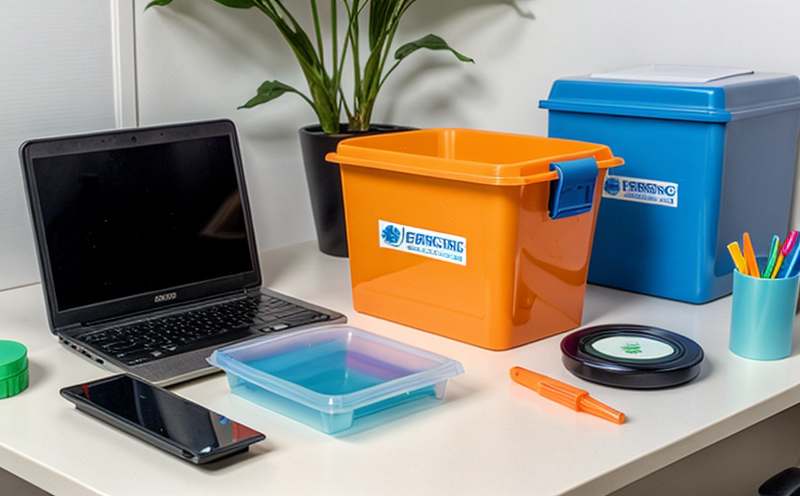ISO 899 Creep Testing of Office Plastic Materials
The ISO standard ISO 899-1 specifies a method for determining the creep behavior and stress relaxation properties of plastic materials under constant load. This testing is particularly relevant in industries where office plastics are used, as it provides critical insights into how these materials perform over time under sustained mechanical loads.
The creep test involves subjecting specimens to a specified load and measuring the change in their dimensions over an extended period. The primary purpose of this test is to evaluate the long-term durability and reliability of plastic components used in office products. This includes items such as desk accessories, file cabinets, and other office furniture. Creep testing helps ensure that these materials can withstand continuous use without deforming or failing prematurely.
The test parameters are meticulously defined in ISO 899-1, which specifies the temperature range (typically between room temperature and 230°C), the duration of the test (often ranging from a few hours to several days), and the load application method. Specimen preparation is also critical; samples must be cut according to precise dimensions and then conditioned in an environmental chamber before testing begins.
The instrumentation used for creep testing includes universal testing machines capable of applying controlled loads over time while simultaneously measuring dimensional changes using displacement sensors or strain gauges. Data collected during the test can include stress-strain curves, load vs. elongation plots, as well as specific values like modulus at yield (EY) and ultimate tensile strength (UTS).
Acceptance criteria for ISO 899-1 tests are stringent and vary depending on the expected service life of the product. For instance, if a desk accessory is designed to last five years or more, it must demonstrate minimal creep deformation after extended exposure under specified loads.
The importance of this test cannot be overstated, especially given the increasingly stringent quality control requirements in manufacturing processes. By adhering strictly to ISO 899-1 standards, manufacturers can ensure that their office plastics meet not only current but also future regulatory expectations. This not only enhances product reliability and safety but also builds consumer trust.
Understanding creep behavior is crucial for optimizing material selection and design iterations. For example, if a particular type of plastic exhibits excessive creep under typical operating conditions, alternative materials or modifications to the design might be necessary to maintain performance standards. Creep testing thus plays a vital role in advancing product development cycles and ensuring compliance with international standards.
Moreover, this testing method is not just confined to office plastics; it extends its relevance across various sectors including automotive, medical devices, and consumer electronics. Its application in these fields underscores the universal applicability of ISO 899-1 for assessing material performance over extended periods under load.
In conclusion, creep testing according to ISO 899-1 is an indispensable tool for quality assurance in the office plastics industry. It ensures that products meet durability and reliability benchmarks, thereby contributing significantly to overall product safety and customer satisfaction.
Benefits
Ensures long-term performance of office plastic components by evaluating their resistance to deformation under sustained loads.
Aids in optimizing material selection and design iterations, leading to improved product quality and durability.
Facilitates compliance with international standards, enhancing market access and regulatory satisfaction.
Enhances customer trust by delivering reliable and safe products that meet high performance expectations.
The benefits of ISO 899-1 creep testing extend beyond the immediate product lifecycle. By identifying potential issues early in the design phase, manufacturers can mitigate risks associated with premature failure or safety hazards. This proactive approach not only improves product quality but also reduces costs related to recalls and repairs.
Furthermore, compliance with international standards like ISO 899-1 is increasingly becoming a competitive advantage for companies operating globally. It demonstrates a commitment to excellence in manufacturing processes and adherence to best practices within the industry.
Industry Applications
Office furniture such as desks, chairs, and filing cabinets.
Stationery items including rulers, scissors, and staplers.
Medical devices like syringes and catheters.
Automotive components subjected to continuous use under load.
Consumer electronics with mechanical stress over extended periods.
The versatility of ISO 899-1 creep testing allows it to be applied across multiple industries, making it a versatile tool for quality assurance. In the office plastics sector specifically, this test is essential for ensuring that materials used in common office supplies can withstand daily use without deforming or failing.
Eurolab Advantages
State-of-the-Art Facilities: Our laboratories are equipped with the latest testing equipment, including advanced universal testing machines capable of precise load application and dimensional measurement. This ensures accurate and reliable data collection for creep testing.
Comprehensive Expertise: Our team comprises highly skilled engineers and scientists who have extensive experience in polymer and plastics testing. They stay updated with the latest developments in the field, ensuring that our tests are conducted according to current best practices.
Compliance Assurance: Eurolab strictly adheres to international standards such as ISO 899-1, guaranteeing that all test results meet or exceed regulatory requirements. This not only simplifies compliance processes for clients but also enhances their reputation in the market.
Customized Solutions: Recognizing that each client has unique testing needs, Eurolab offers customized solutions tailored to specific projects. Whether it’s a one-off test or an ongoing quality assurance program, we can accommodate your requirements effectively and efficiently.
Transparency & Traceability: All our tests are conducted transparently with detailed documentation of every step taken during the process. This ensures complete traceability, providing clients with confidence in the accuracy and reliability of their test results.





